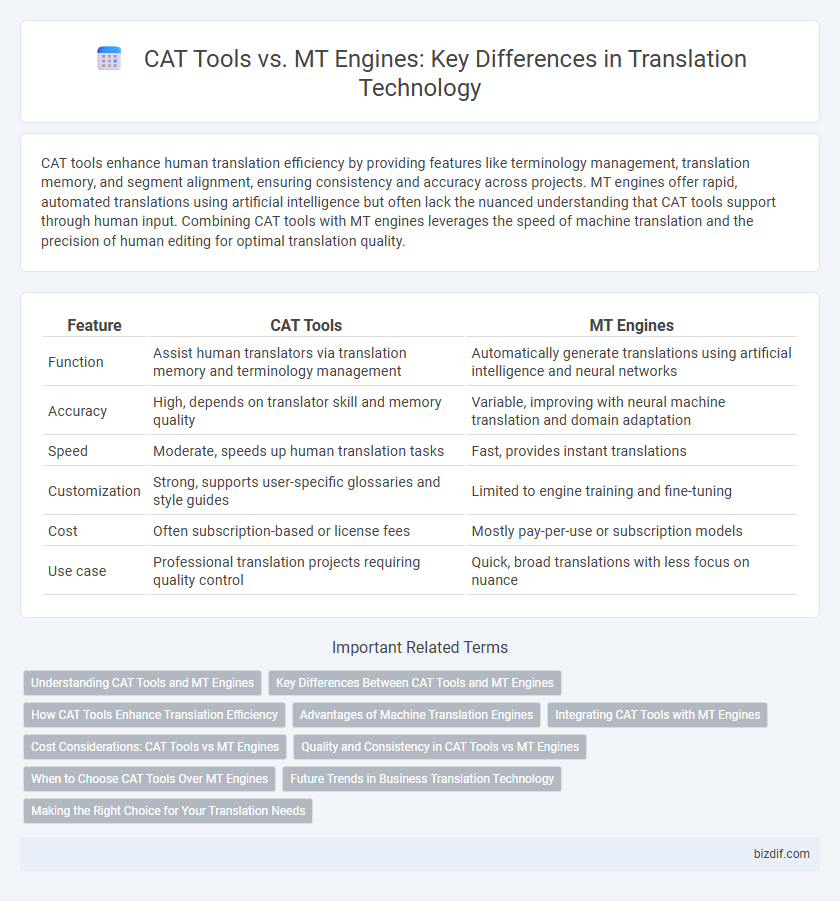CAT tools enhance human translation efficiency by providing features like terminology management, translation memory, and segment alignment, ensuring consistency and accuracy across projects. MT engines offer rapid, automated translations using artificial intelligence but often lack the nuanced understanding that CAT tools support through human input. Combining CAT tools with MT engines leverages the speed of machine translation and the precision of human editing for optimal translation quality.
Table of Comparison
| Feature | CAT Tools | MT Engines |
|---|---|---|
| Function | Assist human translators via translation memory and terminology management | Automatically generate translations using artificial intelligence and neural networks |
| Accuracy | High, depends on translator skill and memory quality | Variable, improving with neural machine translation and domain adaptation |
| Speed | Moderate, speeds up human translation tasks | Fast, provides instant translations |
| Customization | Strong, supports user-specific glossaries and style guides | Limited to engine training and fine-tuning |
| Cost | Often subscription-based or license fees | Mostly pay-per-use or subscription models |
| Use case | Professional translation projects requiring quality control | Quick, broad translations with less focus on nuance |
Understanding CAT Tools and MT Engines
CAT tools streamline translation by providing translators with interactive interfaces that leverage translation memories, terminology databases, and segmentation to enhance consistency and efficiency. MT engines automatically generate translations using neural networks trained on vast multilingual corpora, enabling rapid output but often requiring human post-editing for accuracy and nuance. Understanding the complementary roles of CAT tools and MT engines is essential for optimizing workflow and achieving high-quality, context-aware translations.
Key Differences Between CAT Tools and MT Engines
CAT tools leverage translation memories and terminology databases to enhance consistency and efficiency in human-driven translation workflows, while MT engines generate automatic translations using neural or statistical models. CAT tools require human post-editing to ensure accuracy and context relevance, whereas MT engines provide instant output that varies in quality depending on the algorithm and training data. Integration of CAT tools with MT engines is common to combine human expertise with machine-generated suggestions for optimized translation productivity.
How CAT Tools Enhance Translation Efficiency
CAT tools boost translation efficiency by segmenting texts and storing translations in translation memories, allowing translators to reuse previously translated content and maintain consistency. They integrate terminology management to ensure accuracy and uphold client-specific vocabulary standards. By facilitating collaboration and providing real-time quality checks, CAT tools reduce turnaround time and minimize errors compared to standalone machine translation engines.
Advantages of Machine Translation Engines
Machine Translation (MT) engines offer rapid and scalable translation solutions, significantly reducing turnaround time compared to traditional CAT tools. Advanced neural MT models continuously improve accuracy and fluency by learning from vast multilingual datasets, enhancing consistency across large volumes of content. MT engines also integrate seamlessly with various platforms, enabling real-time translation and cost-efficient management of multilingual projects.
Integrating CAT Tools with MT Engines
Integrating CAT tools with MT engines enhances translation efficiency by combining human expertise with automated processing, enabling translators to leverage machine-generated suggestions within their workflows. This integration supports improved consistency through real-time translation memory alignment and accelerates project turnaround by automating repetitive segments. Leading CAT platforms like SDL Trados, MemoQ, and Wordfast offer seamless API connections to top MT engines such as Google Translate, DeepL, and Microsoft Translator, optimizing accuracy and productivity in multilingual content creation.
Cost Considerations: CAT Tools vs MT Engines
CAT tools often involve upfront licensing fees and ongoing subscription costs that can impact a translation project's budget, while machine translation engines typically offer scalable pricing based on usage volume, making them cost-effective for high-volume tasks. Investment in CAT tools includes training and integration expenses, whereas MT engines reduce human labor costs but may require post-editing to ensure quality. Evaluating cost-effectiveness depends on project complexity, volume, and quality requirements, where CAT tools benefit nuanced translations and MT engines excel in rapid, large-scale deployments.
Quality and Consistency in CAT Tools vs MT Engines
CAT tools ensure higher quality and consistency by leveraging translation memories and glossaries that maintain terminological accuracy across projects. Machine translation engines offer rapid output but often struggle with context-specific nuances and stylistic uniformity compared to human-assisted CAT workflows. Integrating CAT tools with MT engines enhances overall translation quality by combining automated speed with linguistic precision and consistency.
When to Choose CAT Tools Over MT Engines
CAT tools excel in projects requiring high linguistic accuracy, context sensitivity, and consistent terminology management, especially in specialized fields like legal or medical translation. When human post-editing is feasible and maintaining brand voice is critical, CAT tools provide superior control and customization compared to MT engines. Complex texts with idiomatic expressions or nuanced content benefit more from CAT tools, as MT engines often struggle with subtle contextual meanings.
Future Trends in Business Translation Technology
Future trends in business translation technology emphasize the integration of CAT tools with advanced MT engines to enhance translation accuracy and efficiency. Neural machine translation models, supported by large-scale multilingual datasets, enable real-time, context-aware localization for global enterprises. Cloud-based collaboration platforms and AI-driven post-editing tools are revolutionizing workflow automation, reducing turnaround times, and improving consistency in multilingual content management.
Making the Right Choice for Your Translation Needs
Choosing between CAT tools and MT engines depends on your project's complexity and quality requirements; CAT tools enhance translator efficiency by leveraging translation memories and glossaries, while MT engines offer rapid, automated output suited for large volumes. For technical or nuanced texts, CAT tools ensure consistency and accuracy, whereas MT engines excel in handling general content where speed is critical. Assessing factors like domain specificity, desired output quality, and post-editing resources guides the optimal translation technology selection.
CAT Tools vs MT Engines Infographic

 bizdif.com
bizdif.com